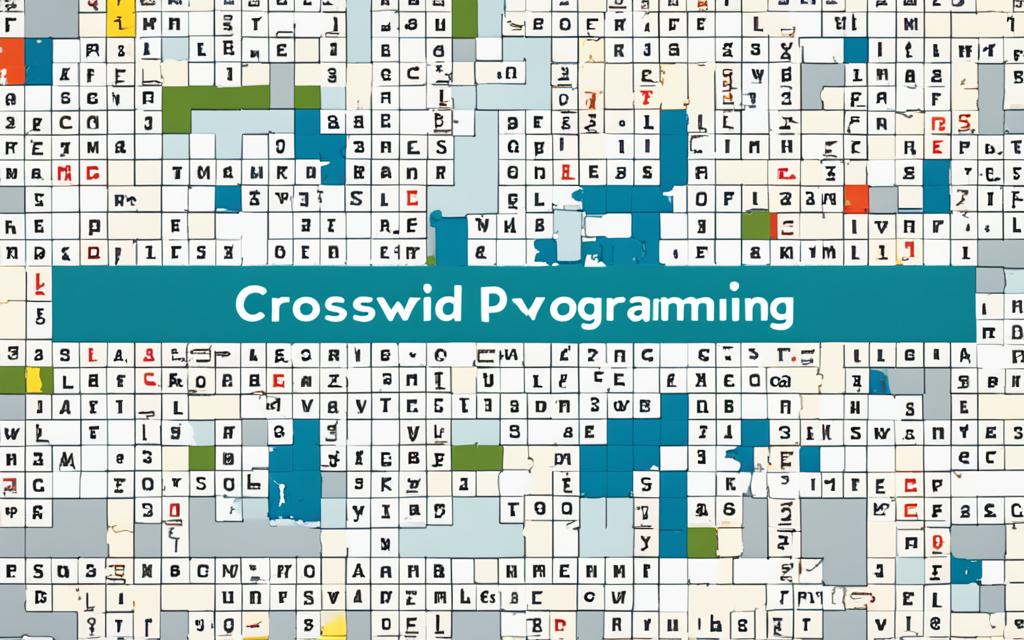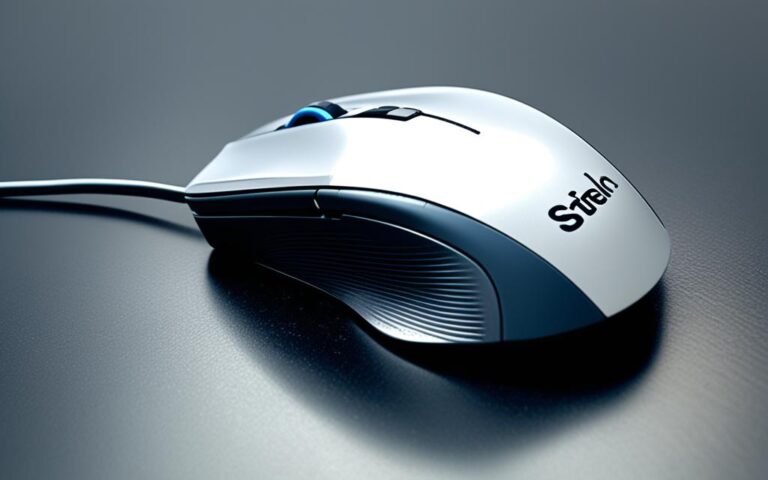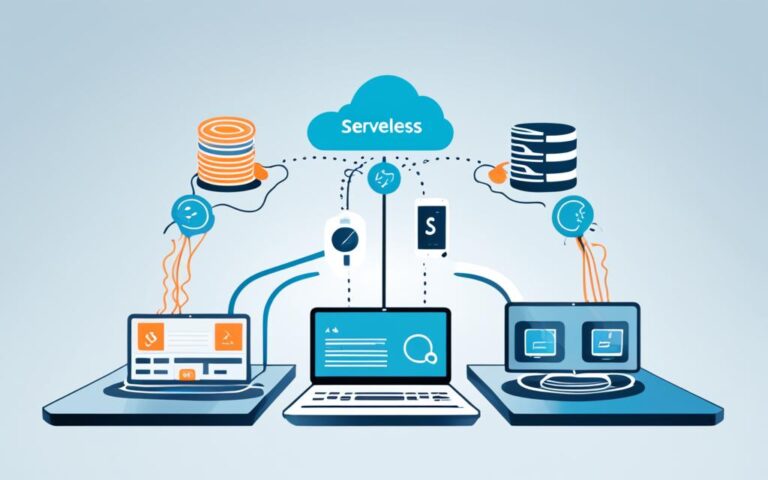Crossword puzzles have been a fun activity since 18731. They keep our minds sharp and help us learn new words. Now, computer programming has changed how we solve crosswords, making it more exciting.
Computer programming has changed the game for crossword puzzles. Thanks to technology, we can now use computers to make, solve, and analyze puzzles easily. This has made crosswords more fun for everyone.
Now, we have special algorithms and software for making and solving puzzles. With WordMint, you can pick from over 500,000 crossword puzzles1. You can also make your own puzzles by choosing a layout and adding clues and answers1. This means you can make puzzles that fit what you like.
Crosswords are great for all ages and reading levels1. They’re perfect for beginners and experts alike. For students, they help improve problem-solving and thinking skills1. They make you think critically and get faster at solving puzzles. Plus, they help you learn new words and how they connect.
Programming also makes crosswords more interactive and fun. The New York Times (NYT) has mini crosswords for those who like shorter puzzles2. Scratch is a great way for kids to start learning programming2. Programming helps NYT create new puzzles every day, keeping puzzle lovers coming back for more2. It’s not just for solving puzzles; it’s also for making games, stories, and managing digital stuff2.
In conclusion, combining computer programming with crossword puzzles has changed how we enjoy these puzzles. With programming, we can make, solve, and explore many different puzzles12. It helps improve our thinking and creativity, making crosswords more fun and accessible than ever.
Key Takeaways:
- Computer programming has made crossword puzzles more fun and easy to do.
- Platforms like WordMint let you pick from many crossword puzzles or make your own.
- Crossword puzzles are great for improving problem-solving and learning new words.
- Programming adds fun and creative elements to solving crosswords.
- The New York Times offers mini crosswords and uses programming to create new puzzles often.
The Role of Computer Programs in Solving Crosswords
Computer programs are key in the world of crosswords. They help enthusiasts solve and create these puzzles more efficiently and accurately. These programs use algorithms and data to generate solutions and suggest clues. The “Proverb” program at Duke University can fill in about 90% of crossword puzzle words accurately3.
These programs have changed how people solve and make crosswords. For solvers, they offer quick help with tricky clues. They use big databases to find possible answers, making it easier to solve puzzles.
For those who create crosswords, these programs are a big help. They need to pay close attention to detail to make puzzles fun and challenging. Programs help by suggesting words for the grid, saving time and offering many options. But, making a good crossword puzzle still requires creativity3.
These programs also give constructors insights into crossword trends. For instance, certain letters like those in “OREO” are often used. They also show that crossword words often start with vowels. This info helps constructors make more engaging puzzles3.
The newspaper industry is changing, and crosswords are finding new homes online. Computer programs help creators share their puzzles with more people. This ensures crosswords remain popular in the digital world3.
Case Study: Proverb’s Impressive Results
| Statistic | Outcome |
|---|---|
| Accuracy in completing crossword puzzles using Proverb program | Approximately 90% |
The “Proverb” program at Duke University has made a big impact on crosswords. It can solve puzzles with about 90% accuracy. This shows how computer programs are changing the game of crosswords3.
How Computer Programs Solve Crosswords
Computer programs are key in solving crossword puzzles. They use advanced algorithms and techniques. The process includes two main steps: candidate generation and grid filling.
Candidate Generation
In the first step, computer programs look for possible answers to clues. They use big word databases and rules of language. Each possible answer gets a score based on how well it fits the clue4.
For example, Crossword Compiler helps puzzle makers by suggesting words for the grid. This makes making puzzles faster and helps find good answers for clues4.
One example is Matt Ginsberg’s “Dr. Fill” program. It shows how computers can solve crosswords well. It even won in competitions like the American Crossword Puzzle Tournament4.
Grid Filling
After finding possible answers, the program fills in the grid. It looks at the scores of each possible answer at each intersection. It picks the combination that scores highest as the answer to the puzzle4.
Computers are great at simple crosswords. But, they find it hard with themed puzzles that need creativity4.
Oliver Roeder of FiveThirtyEight looked into how many possible crossword grids there are. He found 40 billion valid 13×13 grids. This shows how many unique crosswords could be made4.
| Statistical Data from Link 1 | Highlights |
|---|---|
| Some companies use computer programs to generate unthemed crosswords without human intervention. | – |
| Computer programs like Crossword Compiler assist constructors in designing puzzles and filling grids with words. | – |
| Matt Ginsberg’s evolving crossword program, “Dr. Fill,” demonstrates computers’ ability to solve crosswords effectively. | – |
| According to an article in Smithsonian Magazine, computers excel at creating basic, unthemed crosswords but struggle with themed puzzles that require creativity and innovation. | – |
| The vast potential for unique crossword grids demonstrates the limitless possibilities within the world of crosswords, highlighting the challenges faced by AI constructors in keeping up with human creativity. | – |
These statistics show how computer programs help solve crosswords. They assist constructors, generate answers, and improve the certainty score. This proves their value in tackling crossword challenges4.
Smart algorithms, data sources, and programs like “Dr. Fill” are changing crossword-solving. While computers do well in simple puzzles, they struggle with puzzles that need humor, unique themes, or complex letter patterns5.
Specific problematic puzzles for Dr. Fill were puzzles two and five in the contest5.
Dr. Ginsberg, the “Dr. Fill” creator, is a skilled crossword constructor. He has over two dozen puzzles in The New York Times5.
| Statistical Data from Link 3 | Highlights |
|---|---|
| Dr. Fill program finished 141st in the American Crossword Puzzle Tournament against 600 human solvers. | – |
| In simulations of past tournaments, Dr. Fill finished on top three out of 15 times. | – |
| Dr. Fill’s creator, Matthew Ginsberg, predicted the program would likely finish in the top 50 among 600 contestants. | – |
| Dr. Fill excels in conventional crosswords but struggles with puzzles involving humor, unusual themes, or letter arrangements. | – |
| Specific problematic puzzles for Dr. Fill were puzzles two and five in the contest. | – |
| Dr. Ginsberg has over two dozen crossword puzzles published in The New York Times. | – |
| Dan Feyer was the winner of the tournament for the third consecutive time. | – |
In conclusion, computer programs have changed the crossword world. They help constructors, generate answers, and fill grids. While they’re great at simple puzzles, they struggle with complex ones. The future looks bright for crossword-solving programs, but human creativity will always be key45.
Testing the Program: Proverb’s 1999 Tournament Results
Proverb, a puzzle-solving program, was tested at the 1999 crossword tournament. It showed how well it could solve crossword puzzles accurately6. It used 30 different modules to suggest answers to clues with various algorithms and data67.
The tournament had puzzles of different difficulties. Proverb did well on easier puzzles, filling in many correct words6. It got about 95% right on Monday-Wednesday puzzles6. But, it found it harder with Thursday-Sunday puzzles, still scoring around 85%6.
Looking at the results of individual puzzles, we see Proverb’s strengths. In Puzzle 1, it got 73 out of 76 words right, with a few mistakes6. Puzzle 2 was a bit tougher, but Proverb still scored well, getting 87 out of 94 words correct6. Puzzle 3 was a big win, with 112 correct words out of 1206.
Proverb was also tested with puzzles meant to challenge it. Puzzle 4 was one such puzzle, and Proverb struggled, getting only 3 words right6. Puzzle 5 was also tough, but Proverb did better in Puzzle 6, getting 118 out of 122 words correct6.
These results show how good Proverb is at solving crosswords6. It proved to be a powerful tool for crossword fans, thanks to its thorough research and development67.
Cryptic Crosswords and Computer Programs
Cryptic crosswords have long been a puzzle challenge for enthusiasts. They require solvers to decipher clues through wordplay and tricks. While humans have developed strategies, computer programs are now trying to solve these puzzles too. This section looks at how cryptic crosswords and computer programs interact, highlighting the challenges and limits of solving these puzzles.
Computer programs have made great strides in solving regular crosswords. But, cryptic crosswords are a different story. They need an understanding of wordplay and spotting hidden meanings. Programs like Dr. Fill and Crossword Maestro are good at solving regular crosswords but find cryptic clues hard.
Dr. Fill uses pre-existing answers and data from Wikipedia and IMDb8. This helps with regular clues but not cryptic ones. Cryptic crosswords need a deeper understanding of wordplay and tricks.
Crossword Maestro is great at solving UK crosswords8. Yet, it struggles with cryptic clues. Computers are good at solving straightforward clues by using algorithms. But, cryptic clues are too complex for them.
Understanding cryptic crosswords is hard for computers. They can analyze clues but miss the wordplay and humor. Deciphering puns and double meanings is something computers haven’t mastered8.
The Guardian has launched an Android app for crosswords8. This app lets digital enthusiasts solve crosswords on their devices. It could help computers improve at solving cryptic crosswords as technology gets better.
Deciphering the Clues: A Unique Challenge
Decoding cryptic clues is a mix of lateral thinking, linguistic analysis, and creative problem-solving. Humans have developed strategies to solve these puzzles. Computers can try these strategies but struggle to match human ingenuity.
Cryptic crosswords use different types of clues, like anagrams and charades. Each clue type needs a special approach. Humans use their intuition and knowledge to solve them. Computers rely on algorithms and databases.
Despite challenges, computer programs are getting better at solving cryptic crosswords. As algorithms improve and databases grow, computers might one day solve these puzzles well. For now, solving cryptic crosswords is still a human joy. The mix of human creativity and computer power is exciting for the future of solving these puzzles.
Crossword Solvers and the Power of Artificial Intelligence
Artificial Intelligence (AI) is changing how crossword solvers work. Machine learning helps programs recognize patterns in puzzles, making them better at solving. AI lets solvers learn from past experiences.
Machine learning can analyze a lot of crossword data89. This includes word frequencies and clue patterns. Solvers can use this info to solve puzzles better.
Challenges and Limitations Faced by Crossword Solvers
| Challenge | Limitation |
|---|---|
| Deciphering Cryptic Clues | Computer programs struggle to understand the nuances of wordplay and linguistic deception in cryptic crossword clues8 |
| Interpreting Humor in Clues | Computers find it difficult to grasp the humorous elements and subtle jokes often present in crossword clues, limiting their ability to accurately solve comedic or cryptic clues8 |
| Complexity of Puzzles | Cryptic crosswords pose a greater challenge for computer programs due to their intricate clue structures, often requiring lateral thinking and creative problem-solving skills8 |
| Wordplay Nuances | Computer programs struggle to interpret wordplay techniques like anagrams, homophones, and other linguistic tricks commonly found in cryptic crosswords8 |
| Limitations in Understanding Context | Computers face challenges in understanding the contextual clues and cultural references often embedded within crossword puzzles, diminishing their ability to solve clues reliant on specific knowledge or context89 |
Computer programs have made progress in solving crosswords but struggle with cryptic ones. Solving these puzzles needs linguistic skills, intuition, and creative thinking. But, as technology gets better, computers might one day solve cryptic crosswords too.
In the next section, we explore how to set cryptic clues. We’ll look at the creative process behind making puzzles that challenge and engage solvers.
The Art of Setting Cryptic Clues
Creating cryptic crossword clues is an art. It’s about making a surface reading that grabs the solver’s attention. At the same time, it should lead them away from the real answer. These clues are tricky, needing solvers to find hidden meanings and wordplay.
Cryptic clues are famous for their clever distractions. Misleading distractions are key to making crosswords challenging. They make solvers think differently, testing their problem-solving skills.
Surface reading is vital in setting clues. It’s the easy-to-understand part of the clue that doesn’t point to the answer. A good surface reading makes the clue more engaging and fun.
Setting cryptic clues needs careful planning. Clue setters think deeply about every word and punctuation mark. They aim to make clues that are both challenging and enjoyable to solve.
Statistical Insights10
Nutmeg is a skilled crossword setter, working for big names like the Guardian and the Times. She spends four days on each puzzle, focusing on about seven or eight clues a day. Her goal is to set one puzzle weekly.
Nutmeg always has a notebook ready with words and clues. Even during sermons, she thinks of new clues. Her hard work and creativity help her craft clues that are both simple and tricky.
For setting crosswords, Nutmeg uses many dictionaries and thesauruses. These tools help her create puzzles that are both challenging and diverse. They push solvers to think creatively.
Nutmeg believes there aren’t enough female setters because many lack confidence. She encourages women to believe in their skills and join the world of cryptic crosswords. This would make the industry more diverse.
Even though Nutmeg loves her job, she keeps it private at social events. It can take over conversations. Besides crosswords, she’s retired from IT at Manchester University, where she honed her problem-solving skills.
Artificial Intelligence and Cryptic Crosswords
Solving cryptic crosswords is a big challenge that needs both smarts and a knack for figuring out tricky clues. Over time, AI has become a big help in tackling these puzzles. AI uses language processing, search algorithms, and statistical analysis to help solve these puzzles.
Cryptic crosswords started in the UK around 1923. They became popular in the 1920s and 1930s when newspapers like The Daily Telegraph and The Times featured them. Torquemada is known as the father of cryptic clues and invented the cryptic crossword11. Afrit later perfected the art of setting fair clues in his book Armchair Crosswords11.
Recently, AI has changed how we solve cryptic crosswords. The New Yorker started a weekly cryptic puzzle series in April 2018, making them more popular in the US11. After COVID-19, cryptic crosswords became even more popular, with many new outlets and setters joining in11. Papers like The Sydney Morning Herald and The Age now publish daily cryptic crosswords, showing their global appeal11.
The Role of AI in Solving Cryptic Crosswords
AI crossword solvers use many techniques to tackle cryptic clues. They break down clues into parts to find possible answers and hidden meanings. This helps them understand the clues better.
Search algorithms help AI solvers look through a huge database of words. They use dictionaries and the internet to find possible answers for clues12. Statistical analysis also helps by looking at word patterns in crosswords. This makes AI solvers more likely to guess the right answers.
AI in solving crosswords has sparked a lot of debate. Some people see it as a great tool for solving tough puzzles. Others think it’s not fair to use machines instead of our brains13. There are different views on this topic from crossword fans and AI experts13.
The Future of AI in Cryptic Crosswords
As technology gets better, AI’s role in solving crosswords will grow. Better natural language processing and machine learning will help AI understand clues better. AI could also change how puzzles are made, creating new and challenging ones12.
AI could also help with learning and improving at crosswords. Educational tools could use AI to give personalized hints and feedback. This could help people get better at solving cryptic crosswords12.
AI’s impact on cryptic crosswords is huge. It combines human smarts with computer power. As AI gets better, it brings new ways to solve these puzzles. The debate about AI in crosswords will continue, but its effect is undeniable13.
The Evolution of Crossword Solving Programs
Crossword solving programs have changed a lot since they started. They use computer power and puzzle-solving tech to change how we solve crosswords. Thanks to AI and better thinking, these programs can now solve even the toughest puzzles easily. Let’s see how these programs have changed and their big impact on puzzles.
The Early Days: From Dr. Fill to Proverb
“In the 2012 American Crossword Puzzle Tournament, the computer program Dr. Fill ranked 141st out of 660 entries, completing the final playoff puzzle in just 49 seconds14. This milestone showed how fast computer programs were getting better at solving crosswords.”
Dr. Fill was a key early program that showed what puzzle-solving tech could do. It uses AI to figure out answers and spot themes in puzzles14. Dr. Fill has a huge database of past puzzles and uses it to find the best words for each spot in a puzzle14. It worked with the Berkeley Natural Language Processing group to get better at understanding clues and solving puzzles14.
| Year | Key Milestones |
|---|---|
| 2012 | Dr. Fill ranks 141st in the American Crossword Puzzle Tournament14 |
| 2020 | Proverb, an advanced crossword solving program, emerges |
| Present | Crossword solvers continue to improve and advance |
Recently, Proverb has become a top crossword solver. It uses smart ways to figure out puzzles, like looking through lots of clues and solving problems step by step15. This has changed puzzle-solving tech a lot, making programs like Proverb very good at solving puzzles15. These changes have opened up new ways to solve puzzles.
Gender Demographics and the Digitization of Crossword Construction
“Before Will Shortz, women made about thirty-five percent of all puzzles, but by 1993-2013, it was only nineteen percent15. By 2020, women made about thirty-five percent of Crossword Compiler’s U.S. sales15. This change might be because more women use the software for teaching, while men use it more in publishing, as Antony Lewis noticed15.”
As crossword solvers get better, they’re changing puzzle-solving tech a lot. They can solve even the hardest clues and puzzles, showing how computers think in a logical way16. Solving crosswords is like fixing code, finding mistakes and making things better16.
These programs have changed how we solve puzzles and pushed thinking to new levels. They break down hard problems into smaller steps and find patterns to solve them. This is similar to how computers and people solve puzzles, showing the power of logical thinking16.
Challenges and Limitations of Crossword Solvers
Solving crosswords is a complex task that needs language skills, pattern spotting, and logical thinking. Computer programs like GPT-3 and GPT-4 have improved at solving crosswords. Yet, they still face challenges and limitations17.
When puzzles have few exact matches, programs struggle. To overcome this, more modules or algorithms are needed. These help expand the search for possible answers17.
Cryptic clues are a big challenge for computers. They are tricky and need a clever approach to understand. These clues use wordplay and hidden meanings, making them hard for programs to get right18.
LLMs are good at deductive reasoning but struggle with inductive reasoning. Inductive reasoning is about making general rules from specific examples. Crosswords often require this skill to find the right answers. LLMs are getting better but still need to improve here17.
Understanding the different types of puzzles helps us see the challenges solvers face. Some puzzles, like Sudoku, need strategy and game rules knowledge. Others, like riddles, rely on the model’s knowledge. Knowing these differences helps us see what solvers struggle with17.
Helping LLMs solve puzzles is key. Techniques like few-shot in-context learning help the model use a few examples to solve more puzzles. These methods boost the model’s reasoning and solving skills17.
Chain topologies, like Chain-of-Thought and Self-Refine, guide LLMs to solutions. They help the model focus and make better decisions, improving accuracy17.
Rule-less puzzles are harder for LLMs than rule-based ones. They need broader reasoning and real-world knowledge. This makes them more challenging for computers17.
Studies have looked into how experts and non-experts solve crosswords. A study with 28 participants showed experts scored higher on tests of intelligence. Experts were faster and scored better, showing intelligence matters in solving crosswords18.
In conclusion, crossword solvers have made great strides but still face hurdles. Challenges include complex puzzles, cryptic clues, and inductive reasoning. More research and better methods will help solvers. But, human expertise is key to solving puzzles precisely.
The Future of Crossword Solving Programs
The future of crossword solving looks bright. Advances in AI, natural language processing, and machine learning will change the game. These changes will make crossword solvers more accurate, faster, and more efficient.
One big area for improvement is solving cryptic clues. These clues are tricky, needing solvers to think creatively. AI and machine learning will help solvers crack these clues better, making solving puzzles faster and more fun.
These programs will also get better at tackling tough puzzles. By learning from past puzzles, they can develop better strategies. This means they’ll spot patterns and common words quicker, leading to faster and more correct answers.
Another exciting thing is how crossword solvers will work with other AI tech. Natural language processing and deep learning will help solvers understand clues better. This means they’ll not just see words but also get the deeper meaning behind them, making solving puzzles more accurate.
As crossword solving programs grow, they’ll work better with humans and AI. Experts and puzzle fans will team up to make solvers better. This mix of human creativity and AI power will lead to solvers that are not just accurate but also fun to use.
The future is bright for crossword solving programs. With AI advancements, solving crosswords will be more advanced, intuitive, and precise. Puzzle lovers can look forward to a future where these tools are essential, offering both help and a challenge.
Case Study: Crossword Solving Program Successes and Challenges
Crossword solving programs have shown great success in tackling complex puzzles. They prove their worth in solving puzzles with their advanced language skills and AI. Proverb, a program, has made a big impact by solving tough puzzles22.
The team behind Proverb aimed to solve a Saturday New York Times crossword in one go, without help. They chose this challenge because Saturday puzzles are the toughest. They wanted to show how well the program could handle complex clues and wordplay22.
After 46 hours of practice, the Proverb team made it happen. They shared their journey in 31 blog posts, showing how they improved the program’s skills22.
One big challenge for these programs is the increasing difficulty of puzzles throughout the week. The New York Times puzzles get harder from Monday to Saturday. Proverb was designed to tackle the toughest puzzles, like those on Saturday22.
Another challenge is the variety in puzzle sizes. Monday to Saturday puzzles are 15×15, but Sunday’s is 21×21. Proverb’s success in solving puzzles of different sizes shows its flexibility22.
Proverb worked hard to solve puzzles faster, aiming for a 9-minute solve time. This was to match the speed and accuracy of expert solvers. It pushed the limits of what computers can do with crosswords22.
Even with their successes, crossword solving programs face hurdles. Proverb used the “check” and “reveal” options on the New York Times website to help. This helped solve about 27% of the puzzle quickly, balancing speed with a true puzzle-solving experience22.
Early tests aimed to cut solve time to about 20 minutes. These tests helped improve strategies and decision-making. This made the program better at solving puzzles22.
Finding the right balance between using shortcuts and solving puzzles on your own is key. This balance makes solving crosswords both fun and rewarding22.
A Comparative Study of Crossword Solvers
A study looked at 28 crossword solvers, with 18 identified as experts. Experts scored higher in various areas, showing their skill18.
The study found a link between solving time and AH5 scores. Solvers with higher AH5 scores solve puzzles faster. This shows how important skills like pattern recognition and analytical thinking are in solving crosswords18.
The study matched solvers by age, education, and experience. This helped focus on how expertise affects solving performance18.
This study mainly looked at traditional crosswords. But it noted the unique challenges of cryptic crosswords. Solving these puzzles requires special skills like pattern matching and creative thinking23.
The study questioned the idea that expertise comes only from practice. It suggested a more complex view of expertise, highlighting the many skills needed for crossword solving23.
A Crossword Solving Landscape Examined
Research has looked at expertise in areas like chess and music. A study compared Scrabble skills with US-style crossword solving. US-style crosswords focus on word knowledge and meanings23.
British-style cryptic crosswords are different, needing lateral thinking and wordplay. They require skills beyond just knowing words23.
US-style crossword solvers often have strong verbal skills. This reflects the puzzle’s focus on language and vocabulary23.
Conclusion
Computer programs, powered by AI and natural language processing, have changed how we solve crossword puzzles. These tools are incredibly accurate and efficient at cracking even the toughest clues24.
The future of crossword-solving technology looks bright. As these tools get better, puzzle lovers can expect more exciting challenges and victories. The mix of human creativity and computer power opens up new possibilities for solving crosswords24.
Using statistical data24 and AI has made crossword-solving programs more powerful. These tools don’t just solve puzzles; they also teach us about computer science and programming issues. They can handle different words for problems and know a lot about baseball, showing their wide range of knowledge25.
In conclusion, crossword-solving technology has changed how we tackle puzzles. The blend of human smarts and computer power has ushered in a new era of puzzle-solving. As technology keeps improving, the future of crossword programs is full of promise. It offers puzzle fans the chance to enjoy challenging and rewarding puzzle-solving experiences. The adventure in solving crosswords is just starting, and we’re excited for what’s to come2425.
FAQ
What are crossword solving programs?
Crossword solving programs are computer tools. They use algorithms and data to solve crossword puzzles efficiently.
How do computer programs solve crosswords?
They solve crosswords in two steps. First, they generate possible answers for clues. Then, they pick the best ones to fill the puzzle.
Can computer programs solve cryptic crosswords?
Yes, they can solve cryptic crosswords. But, these puzzles are tricky because they use wordplay and tricks.
What is the art of setting cryptic crossword clues?
Setting cryptic clues is an art. It involves making clues that seem unrelated to the answer. They use wordplay and tricks to make puzzles fun.
How do computer programs tackle cryptic crossword clues?
They use special modules and algorithms. These help them understand the clues in a cryptic way, combining logic and word skills.
How do crossword solvers utilize artificial intelligence?
Solvers use AI for language processing and solving clues. They also use search algorithms and statistical analysis to improve their puzzle-solving skills.
How have crossword solving programs evolved over time?
These programs have grown by using new computer science and AI. They use efficient methods and big databases to solve puzzles accurately.
What challenges do crossword solvers face?
Solvers might struggle with puzzles that don’t have clear answers. Cryptic clues can also be hard for computers to understand.
What does the future hold for crossword solving programs?
The future looks bright for these programs. Advances in AI and natural language processing will make them better at solving puzzles.
Have crossword solving programs demonstrated success?
Yes, programs like Proverb have done well. They show how technology can solve crosswords. But, they need fast processing and can struggle with tricky clues.
How have crossword solvers revolutionized puzzle-solving?
Solvers have changed puzzle-solving with AI and natural language processing. They offer better accuracy and make solving puzzles more fun.
How can researchers further improve crossword solving programs?
Researchers can make programs better by studying successful examples. They should look for new solutions to improve the technology.
What can crossword enthusiasts expect in the future?
As technology gets better, enthusiasts can look forward to more accurate and fun puzzle-solving. Solvers will get better at solving even the toughest clues.
Source Links
- https://wordmint.com/public_puzzles/324062 – Computer Programming Crossword
- https://techguruidea.com/learning-computer-programming-with-nyt-crosswords/ – Learning Computer Programming With NYT Crosswords! – 2024
- https://magazine.caltech.edu/post/grid-guru – Puzzled: The Story of the Crossword-Creating Caltech Alum — Caltech Magazine
- https://blog.puzzlenation.com/2019/02/26/how-far-away-are-computer-generated-crosswords/ – How Far Away Are Computer-Generated Crosswords?
- https://bits.blogs.nytimes.com/2012/03/18/in-crosswords-man-over-machine-for-now/ – In Crosswords, It’s Man Over Machine, for Now
- https://www.crosswordtournament.com/1999/art4.htm – Proverb, the Crossword-Solving Computer Program [22nd Annual ACPT, 1999]
- https://www.sciencedaily.com/releases/1999/04/990420064821.htm – Duke Researchers Pit Computer Against Human Crossword Puzzle Players
- https://www.theguardian.com/crosswords/crossword-blog/2012/mar/08/crossword-blog-computers-crack-cryptic-clues – Crossword blog: can computers crack cryptic clues?
- https://crypticcrosswords.net/crosswords/usual-suspects/ – The Usual Suspects
- https://www.theguardian.com/crosswords/crossword-blog/2017/apr/10/crossword-blog-meet-the-setter-nutmeg – Crossword blog: meet the setter – Nutmeg
- https://en.wikipedia.org/wiki/Cryptic_crossword – Cryptic crossword
- https://newscientist.com/article/dn9888-crossword-software-thrashes-human-challengers/ – Crossword software thrashes human challengers
- https://news.ycombinator.com/item?id=33873502 – ChatGPT vs. a Cryptic Crossword
- https://www.sciencefriday.com/segments/computer-crossword-puzzle/ – This Computer Won The 2021 American Crossword Puzzle Tournament
- https://www.newyorker.com/books/page-turner/what-turned-crossword-constructing-into-a-boys-club – What Turned Crossword Constructing Into a Boys’ Club?
- https://www.linkedin.com/pulse/from-clues-code-computational-blueprint-crossword-puzzles-jones-lj6ue – From Clues to Code: The Computational Blueprint of Crossword Puzzles
- https://arxiv.org/html/2402.11291v2 – Puzzle Solving using Reasoning of Large Language Models: A Survey
- https://www.journalofexpertise.org/articles/volume3_issue2/JoE_3_2_Friedlander_Fine.pdf – PDF
- https://www.hpcwire.com/1999/04/23/scientists-pit-computer-vs-human-crossword-puzzle-players/ – SCIENTISTS PIT COMPUTER VS HUMAN CROSSWORD PUZZLE PLAYERS
- https://www.cam.ac.uk/research/news/ai-crossword-solving-application-could-make-machines-better-at-understanding-language – AI crossword-solving application could make machines better at understanding language
- https://www.bbc.com/news/technology-56934716 – ‘I was terrible at crosswords so I built an AI to do them’
- https://medium.com/@maxdeutsch/how-i-mastered-the-saturday-nyt-crossword-puzzle-in-31-days-fe6a094edccd – How I mastered the Saturday NYT crossword puzzle in 31 days
- https://www.ncbi.nlm.nih.gov/pmc/articles/PMC4853387/ – The Grounded Expertise Components Approach in the Novel Area of Cryptic Crossword Solving
- https://crosswordlabs.com/category/computer?page=20 – Computer Crossword Puzzles – Page 20
- https://www.crosswordsolver.org/clues/p/program-problem.36557 – Program problem Crossword Clue Answers


















